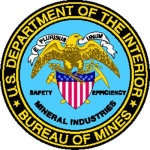- Branża: Mining
- Number of terms: 33118
- Number of blossaries: 0
- Company Profile:
The U.S. Bureau of Mines (USBM) was the primary United States Government agency conducting scientific research and disseminating information on the extraction, processing, use, and conservation of mineral resources.
Founded on May 16, 1910, through the Organic Act (Public Law 179), USBM's missions ...
A brake which acts directly on the Koepe sheave and can be applied by the winding engine operator's brake lever and the other safety devices.
Industry:Mining
A branch of geochemistry that deals with the effects of life processes on the distribution and fixation of chemical elements in the biosphere.
Industry:Mining
A branch of geology dealing with the broad architecture of the outer part of the Earth; i.e., the regional assembling of structural or deformational features, a study of their mutual relations, origin, and historical evolution. It is closely related to structural geology, with which the distinctions are blurred, but tectonics generally deals with larger features. Adj: tectonic.
Industry:Mining
A branch of geology dealing with the broad architecture of the outer part of the Earth; i.e., the regional assembling of structural or deformational features, a study of their mutual relations, origin, and historical evolution. It is closely related to structural geology, with which the distinctions are blurred, but tectonics generally deals with larger features. Adj: tectonic.
Industry:Mining
A branch of geophysics that acquires and interprets airborne or satellite images of the surface using infrared and visible wavelengths of light.
Industry:Mining
A branch of physics dealing with the Earth, including its atmosphere and hydrosphere. It includes the use of seismic, gravitational, electrical, thermal, radiometric, and magnetic phenomena to elucidate processes of dynamical geology and physical geography, and makes use of geodesy, geology, seismology, meteorology, oceanography, magnetism, 1352 and other Earth sciences in collecting and interpreting Earth data. Geophysical methods have been applied successfully to the identification of underground structures in the Earth and to the search for structures of a particular type, as, for example, those associated with oil-bearing sands.
Industry:Mining
